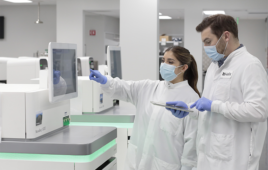A Brown University research team has discovered something in the brain that could serve as a target for future autism and mental retardation treatments.
Discovery of the novel Fragile X granule is detailed in the Journal of Neuroscience. This finding opens a new line of research about potential treatments for autism, a neurological disorder that strikes young children, and can impair development of social interaction and communication.
‘If you are going to treat the disease you need to be able to target the defective elements,’ said Justin Fallon, professor of neuroscience at Brown. ‘The Fragile X granule offers such a target.’
Autism can be caused by a variety of genetic factors, but Fallon’s lab focused on one particular area — the Fragile X protein. If that protein is mutated, it leads to Fragile X syndrome, which causes mental retardation and is often accompanied by autism.
There is growing recognition in the field that autism and mental retardation are diseases of the synapse, the basic unit of information exchange and storage in the brain. Many groups have extensively studied the role of the Fragile X protein in the post-synaptic, or receiving side of synaptic connections. This was a starting point for the research conducted by Fallon’s team in their study of the Fragile X protein and synaptic connections in healthy mice.
By examining specially prepared sections of mouse brain tissue with high-powered light and electron microscopes, Fallon’s team made a number of determinations. First, they showed that Fragile X exists at the pre-synaptic, or sending side of the synapse. This is an area that had not been widely studied.
‘For over 25 years the field has focused almost exclusively on the post-synaptic, receiving side,’ Fallon said. ‘Almost no one has looked at the pre-synaptic side, as it was not thought to be involved in Fragile X.’
This discovery is important because scientists, if they are to treat Fragile X syndrome, autism, or mental retardation, must know where the functional defect actually is. Fallon’s research helps fill in a potential gap.
‘The implication is that pre-synaptic defects could contribute to the pathology in autism in Fragile X,’ Fallon said.
Even more significantly, Fallon and his lab learned that Fragile X protein is only present in a small fraction of what are known as pre-synaptic specializations. The pre-synaptic Fragile X protein also turned out to be present in microscopic granules, which look like tiny pebbles under a high-powered microscope. Understanding the Fragile X granule is important in this context because the finding could lead to more targeted treatments.
Further research is needed, but Fallon’s lab hypothesizes that the granules contain multiple RNAs, or sets of genetic information to help modify the synapse during learning and memory. If their theory is proven correct, the granules might serve as pinpoint targets for eventual drug treatments of autism.
Release Date: February 4, 2009
Source: Brown University
Filed Under: Genomics/Proteomics




